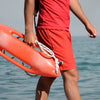Lifeguard Dress Code: Ensuring Safety, Professionalism, and Readiness
In the world of lifeguarding, attire isn’t just a matter of fashion; it’s a critical aspect of the profession. Lifeguards’ dress code is carefully designed to prioritize safety, professionalism, and the ability to respond effectively to emergencies. In this blog, we’ll explore the essential elements of the dress code for lifeguards and its significance in their crucial role of ensuring aquatic safety.
The Purpose of a Lifeguard Dress Code:
1. Visibility and Identification:
• The primary objective of a lifeguard’s dress code is to be easily identifiable. Vibrant colors, commonly red, orange, or yellow, are chosen for their high visibility against water, enabling swift recognition by those in need of assistance.
2. Professionalism and Unity:
• Uniformity among lifeguards fosters a sense of professionalism within the team. A consistent dress code promotes unity, a shared identity, and reinforces the lifeguard team’s commitment to safety and readiness.
3. Functional Design:
• Lifeguard attire is designed to be functional and practical. It allows for ease of movement, comfort, and quick response during water-based emergencies while ensuring modesty and protection from the elements.
Components of Lifeguard Dress Code:
1. Swimwear:
• One-piece or two-piece swimsuits in bright, high-visibility colors are a staple of lifeguard attire. These suits are chosen for their durability, functionality, and ability to provide support and coverage during rescues.
2. Rash Guards and T-shirts:
• Rash guards or T-shirts are often part of a lifeguard’s attire, providing additional protection against the sun and abrasions. They may also feature the lifeguard’s affiliation or identification markings.
3. Board Shorts, Pants, or Skirts:
• Lifeguards might wear Board shorts, pants, or skirts as part of their uniform. These garments, often in complementing colors, are chosen for their functionality and durability while allowing for freedom of movement.
4. Hats, Visors, and Footwear:
• Branded hats or visors with high visibility accents are common in lifeguard attire. Water-resistant footwear, such as water shoes or sandals with good traction, is essential for protecting the feet while navigating slippery surfaces.
Adherence to Safety Standards:
1. Sun Protection:
• Lifeguards prioritize sun safety, often incorporating clothing and accessories that provide protection against harmful UV rays. This includes wearing hats, sunglasses, and applying sunscreen regularly.
2. Compliance and Maintenance:
• Adhering to the dress code ensures compliance with safety regulations set by governing bodies. Lifeguards are responsible for maintaining their attire in good condition to ensure functionality and professionalism at all times.
Conclusion:
The dress code for lifeguards isn’t merely about fashion or aesthetics; it’s a strategic choice rooted in safety, professionalism, and preparedness. Every aspect of their attire, from the vibrant colors to the functional design, serves a specific purpose - ensuring visibility, ease of identification, and readiness to respond effectively to water-related emergencies.
Understanding the importance of the lifeguard dress code underscores the dedication and responsibility these professionals carry in safeguarding the lives of individuals in aquatic environments. It signifies their commitment to excellence, unity, and the critical role they play in ensuring the safety of beachgoers, pool users, and water enthusiasts.
The Purpose of a Lifeguard Dress Code:
1. Visibility and Identification:
• The primary objective of a lifeguard’s dress code is to be easily identifiable. Vibrant colors, commonly red, orange, or yellow, are chosen for their high visibility against water, enabling swift recognition by those in need of assistance.
2. Professionalism and Unity:
• Uniformity among lifeguards fosters a sense of professionalism within the team. A consistent dress code promotes unity, a shared identity, and reinforces the lifeguard team’s commitment to safety and readiness.
3. Functional Design:
• Lifeguard attire is designed to be functional and practical. It allows for ease of movement, comfort, and quick response during water-based emergencies while ensuring modesty and protection from the elements.
Components of Lifeguard Dress Code:
1. Swimwear:
• One-piece or two-piece swimsuits in bright, high-visibility colors are a staple of lifeguard attire. These suits are chosen for their durability, functionality, and ability to provide support and coverage during rescues.
2. Rash Guards and T-shirts:
• Rash guards or T-shirts are often part of a lifeguard’s attire, providing additional protection against the sun and abrasions. They may also feature the lifeguard’s affiliation or identification markings.
3. Board Shorts, Pants, or Skirts:
• Lifeguards might wear Board shorts, pants, or skirts as part of their uniform. These garments, often in complementing colors, are chosen for their functionality and durability while allowing for freedom of movement.
4. Hats, Visors, and Footwear:
• Branded hats or visors with high visibility accents are common in lifeguard attire. Water-resistant footwear, such as water shoes or sandals with good traction, is essential for protecting the feet while navigating slippery surfaces.
Adherence to Safety Standards:
1. Sun Protection:
• Lifeguards prioritize sun safety, often incorporating clothing and accessories that provide protection against harmful UV rays. This includes wearing hats, sunglasses, and applying sunscreen regularly.
2. Compliance and Maintenance:
• Adhering to the dress code ensures compliance with safety regulations set by governing bodies. Lifeguards are responsible for maintaining their attire in good condition to ensure functionality and professionalism at all times.
Conclusion:
The dress code for lifeguards isn’t merely about fashion or aesthetics; it’s a strategic choice rooted in safety, professionalism, and preparedness. Every aspect of their attire, from the vibrant colors to the functional design, serves a specific purpose - ensuring visibility, ease of identification, and readiness to respond effectively to water-related emergencies.
Understanding the importance of the lifeguard dress code underscores the dedication and responsibility these professionals carry in safeguarding the lives of individuals in aquatic environments. It signifies their commitment to excellence, unity, and the critical role they play in ensuring the safety of beachgoers, pool users, and water enthusiasts.
- Posted in Lifeguard Board Shorts, Lifeguard Outfit, Lifeguard Shorts, Lifeguard Swimsuit, Lifeguard Swimwear

